Elizabeth Poole Stillwagon: Is she one of the Molly Pitchers of Revolutionary War Legend?
In the lead up to Ken Burns’ new documentary, The American Revolution, I have continuously been seeing advertisements for the premier this coming weekend. Inspired by the advertisement that quotes Benjamin Franklin from his letter to Samuel Cooper on May 1, 1777, in which Franklin says, “our Cause is the Cause of all Mankind”, it inspired me to write a little something about an ancestor of my wife, Megan. Her ancestor is Elizabeth Poole Stillwagon, her 5th great grandmother. All people will say, “well who the hell is that?” We’ll get to that shortly.
During the American Revolution, the was representation from all classes, races, and both sexes in service of the patriot cause. An enduring story and legacy is the story of Molly Pitcher. But who was Molly Pitcher? The most common belief is that a woman named Mary Ludwig Hays McCauley was the real Molly Pitcher and that she brought water to troops at the Battle of Monmouth in 1778, and that she took her husbands place at the artillery piece he was manning after he collapsed during the battle. But a couple of other names have popped up over the years as to who was the “real” Molly Pitcher. Names such as Margaret Corbin who took her husbands place at a cannon after he was killed at the Battle of Fort Washington in 1776.
Numerous stories abound about women’s roles in the Revolutionary War. Women who donned the uniform dressed as men to do their part. Women who stayed back home to rear families while their husbands were away fighting, they nonetheless bore the brunt of the most glorious cause. Women followed their husbands on campaigns, cooking, sewing, and washing their clothes to do their parts. And yes, the number of stories where women stepped into their husbands’ roles when they either fell dead or wounded, collapsed from exhaustion, or were captured. Today the story and legend of Molly Pitcher is now believed by many in the field of history to be an amalgamation of a number of women who stepped into the roles that their men filled when they were needed. And many of those women, heroically and without pause stepped up to the plate, showing that they could do what their men could do, when their country needed them most.
It is mostly known only locally and in my wife’s family lore that they have a claim to a heroin from the Revolutionary War who is believed to have been one of the many Molly Pitchers. On the eve of Ken Burns, The American Revolution, I want to make it more widely known, my wife’s family’s claim to that most legendary of stories that come from the era that tried men’s souls.
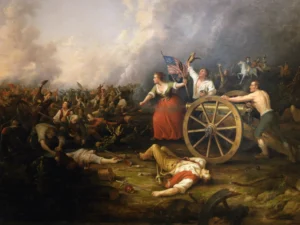
Molly Pitcher at the Battle of Monmouth, by Dennis Malone Carter, 1854.
My wife’s 5th great grandmother, Elizabeth Poole, it is believed, was born around 1751 in Pennsylvania. She married Peter Stillwagon, a German immigrant, on March 10, 1773 in Philadelphia at the German Lutheran Church. Peter joined the patriot cause around the time of the signing of the Declaration of Independence. Records and local histories are ambiguous on which regiments he served in. Some local and family histories say he served at some point in a Pennsylvania regiment. Some common facts among all records though are that he served as a sergeant in a company commanded by a Captain Fleming, the regiment being commanded by a captain or colonel Holmes. There is a Captain Stephen Fleming who commanded a company of New Jersey Militia in a regiment commanded by Colonel Asher Holmes.

Marriage record from the supposed Family Bible of the Stillwagon family, courtesy Fold3.com.
Shortly after Peter enlisted, Elizabeth gave birth to their first child, Daniel, in New Jersey to where the family had moved. New Jersey was a hotbed for Loyalist activity during the war, as the British were nearby in New York and Philadelphia during the war. Elizabeth and her new family suffered depredations while Peter was away during the war. British troops visited the family home in New Jersey and treated Elizabeth harshly and plundering their home. Just before the Battle of Trenton in December 1776, British troops under the command of David Smith raided the Stillwagon home and took what was left and burned the house to the ground. Upon hearing that the British troops were on their way, Elizabeth took her family to a neighbor’s house. In regards to this, at the age of 84, Elizabeth said, “after her husband was taken prisoner the British troops came to her house and destroyed what they could find, even the clothing of her children after being treated so meanly by the British soldiers when they were at her house she became alarmed for her own.” Peter was at some point captured and held prisoner for twenty-three months at one of the sugar houses in New York City, which were makeshift prisons used by British forces in the Revolution. Upon applying to David Forman, a brigadier general of New Jersey Militia, she was placed in a home with the wife of Captain Joshua Huddy, who himself was captured by the British at Toms River and hung.
After the loss of her home in New Jersey, Elizabeth sought refuge with her husband in camp, upon the approval of his commanding officer. Peter was involved in the battles of Colts Neck, Brandywine, Germantown, Trenton, and Monmouth. In camp, Elizabeth served numerous purposes including washing and baking for the soldiers and helping to tend wounded soldiers. Family and local histories say she stepped into the role of combatant at the Battle of Monmouth on June 28, 1778 by carrying ammunition for the artillery in the battle. Maybe her and Mary Ludwig Hays McCauley both worked together in the battle serving with the men in the artillery when men had fallen wounded or killed. Peter would go on to serve for five years during America’s war for independence, and much of that service, Elizabeth was there with and for him, sharing in many of the same hardships that he did.
Peter and Elizabeth would go on to have thirteen children, all of whom were born in New Jersey. Sometime after the war, the family moved to Connellsville in Fayette County, Pennsylvania. Peter Stillwagon died in December 1831. For many years, Elizabeth received a widows pension for her husbands Revolutionary War service. In order to receive her pension, she had to testify under oath in 1846 in Fayette County:
State of Pennsylvania
Fayette County PA
On this 6th day of May 1846
Before me one of
the judges of the Court of Common pleas of the County of Fayette, State of Pennsylvania appeared Elizabeth Stillwagon of the Borough of Connellsville in the County of Fayette, State of Pennsylvania aged about Ninety five years who being duly sworn according to law doth on her oath make the following Declaration in order to obtain the benefit of the acts of Congress made for and in behalf the soldiers of the Revolutionary War and their widows.
That she was
Married to Peter Stillwagon in the year 1773 in the City of Philadelphia State of Pennsylvania and that to the best of her recollection which is much impaired by reason of old age and great length of time that her Husband was a sargeant in the company commanded by Capt. Stephen Fleming Redg Commanded by Col Holmes and General David Forman in the State of Newjersey he first entered the Service in the State of Pennsylvania near to the City of Philadelphia and was marched into the State of Newjersey and it was there I knew him to be under the Command of Capt Fleming Col Holmes & General Forman he was at Colts Neck Monmouth & Eatontown he entered the Service as was as she can recollect about the time of the Declaration of Independance and continued about five years in said service and that he was taken Prisoner at or near Eatontown in the State of Newjersey while he was out on an expedition he with some other Fellow soldiers were captured by British Troops and taken to the City of Newyork and imprisoned in what was called the Sugar House for one year and eleven months and that after her Husband was taken Prisoner the British Troops came to her house and destroyed what they could find even the clothing of his children after being treated so meanly by the British Soldiers when they were at her house she became alarmed for her own safety and she removed to a neighbour house and ____ for them to support herself and her two children after she had left the House in which she had been living, the enemy returned and burnt the house then General Forman furnished her a house in Company with Capt Huddy’s wife, Capt Huddy was taken at Toms River by the British and hung at what was called the Highlands.
All the papers she had were
lost at the time she was moving from place to place and among the number was her certificate of marriage. She has no Discharge nor any paper ____ the Case and Knows of no one living by which those facts Can be proven and that she does not receive any Pension lonely from the State of Pennia and that she relinquishes it upon the granting of one from the Government of the United States and that her Husband Died in the month of December in the year 1831 and that she has remained a widow ever since.
Elizabeth (her mark) Stillwagon
Sworn and subscribed before me this
6th day of May 1846
John Huston Associate Judge
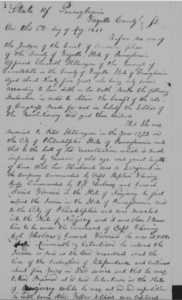
Elizabeth Stillwagon’s pension oath, courtesy Fold3.com.
Elizabeth went on to secure her widows pension for Peter’s service in the Revolutionary War, a pension she received until her death in about 1854 or 1855. Yes, she died at the age of around 104 or 105. And she did not die of natural causes. Family history says she died as a result from burns from an accidental house fire that was set while she was smoking her pipe!!!
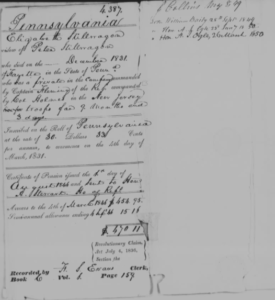
1850 Pension record for Elizabeth Stillwagon, courtesy Fold3.com.
So the question remains, was she one of the many candidates for a Molly Pitcher? Who knows. Mary Ludwig Hays McCauley is the only woman recorded from the Battle of Monmouth having participated in the battle. Over the years, the numerous women purported to have played roles in battles of the Revolution have changed the narrative of Molly Pitcher to being one individual woman, to being a conglomeration of stories of multiple women who were all Molly Pitcher. But not all events in history and actions by individuals are recorded. Peter Stillwagon’s presence at Monmouth does place Elizabeth in the vicinity of the battle, so it’s possible she went out onto the field during the battle, possibly delivering water to soldiers, aiding wounded men, and maybe even delivering ammunition to an artillery unit on another part of the field, separate from Mary McCauley. The decision is up to you, the reader.
References
Case Files of Pension and Bounty-Land Warrant Applications Based on Revolutionary War Service, compiled ca. 1800- ca. 1912, documenting the period ca. 1775-ca. 1900, US, Revolutionary War Pensions, 1800-1900, Fold3.com, https://www.fold3.com/image/18359538/stillwagon-peter-page-25-us-revolutionary-war-pensions-1800-1900, accessed 14 November 2025.
Case Files of Pension and Bounty-Land Warrant Applications Based on Revolutionary War Service, compiled ca. 1800- ca. 1912, documenting the period ca. 1775-ca. 1900, US, Revolutionary War Pensions, 1800-1900, Fold3.com, https://www.fold3.com/image/18359475/stillwagon-peter-page-7-us-revolutionary-war-pensions-1800-1900, accessed 14 November 2025.
Case Files of Pension and Bounty-Land Warrant Applications Based on Revolutionary War Service, compiled ca. 1800- ca. 1912, documenting the period ca. 1775-ca. 1900, US, Revolutionary War Pensions, 1800-1900, Fold3.com, https://www.fold3.com/image/18359464/stillwagon-peter-page-3-us-revolutionary-war-pensions-1800-1900, accessed 14 November 2025.
Jordan, John W. and James Hadden. Genealogical & Personal History of Fayette County, Pennsylvania. Volume 2. New York: Lewis Historical Publishing Company, 1912.
Spero, Patrick. Discovering Elizabeth Poole. The David Library of the American Revolution, 2009, accessed 14 November 2025. https://davidlibraryar.blogspot.com/2009/09/patrons-perspective-discovering.html.

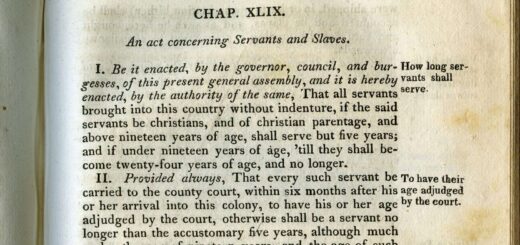

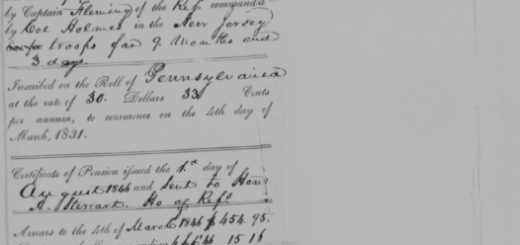

Very interesting article! Great job.